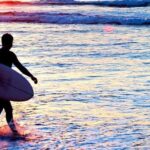
Surfboard Shapes and Designs Explained For Beginners
Whether you're buying your first surfboard, upgrading to a better model or trying out something new, the first thing you need to know is that not all boards are created equal.
To help you pick out the right board for your needs, your abilities and your budget, check out our guide to the wide variety of surfboard sizes, shapes and designs out there. Our friendly surf experts at Boardriders will help you find the perfect match, so you'll be ready to take on the Superbank in no time.
Shortboards
The most popular type of surfboard by far, shortboards offer excellent mobility for performing quick manoeuvres and sharp cuts on waves. The downside of their shorter length is that they are more difficult to stabilise, so not ideal for beginners.
Longboards
Also known as the malibu or mal, longboards are around 1.5x the length of shortboards. They are also wider, usually have a rounded nose and a single fin. These boards offer superior stability if you're worried about falling off and are easier to paddle, but less manoeuvrable.
The Fish
Even shorter than the shortboard, but with extra width, these stumpy boards are designed for riding on smaller waves.
The Gun
A stretched shortboard that can reach greater lengths than a longboard, the gun is specialised for large and fast waves.
Stand Up Paddleboards (SUPs)
Paddle boarding is taking the world by storm, but you need the right type of board to do it. SUPs are designed for cruising on calm lakes or riding the waves, but some boards can handle both.
Dimensions and Contours
It's not just length and width that determine how your board performs – every aspect of its design has an impact, from nose to tail and top to bottom. Some of the most critical things to consider are:
- Profile – Rounded or curved board profiles are more adept at performing tight, fast turns compared to straighter boards.
- Thickness – Thicker boards offer greater floatation for beginners but restrict more advanced manoeuvres.
- Rocker – Nose and tail rockers are the upward curves of the board at both ends, which are precisely engineered for optimal speed and stability.
- Foil – The balanced distribution of foam in the board's construction.
- Contours – The contours of the underside of the board greatly affect its performance. Flat surfaces pick up speed quickly but can be hard to control, concave surfaces channel water through the centre to boost responsiveness and vee designs enhance turning.
Tails and Fins
The nose may lead the way, but when it comes to turning, it's all in the tail. Pin tails feature a smaller surface area and will keep things steady at high speeds, while rounded tails offer smoother turning in medium waves and square tails are ideal for sharp turns.
Your board's fins aren't for decoration either, providing vital stability. Single fins are necessarily larger and produce tighter turns associated with retro and old school boards. The most common set up is the thruster which contains 3 fins providing a combination of stability and drive. Quad fins allow for easy speed whilst the twin fin allows for maximum manoeuvrability.
Find your perfect board at Boardriders
Boardriders has a wide selection of surfboards to suit every rider, from leading brands including Bradley, DHD, Firewire and McTavish.
Visit our flagship Australian store now open at The Strand at Coolangatta.

